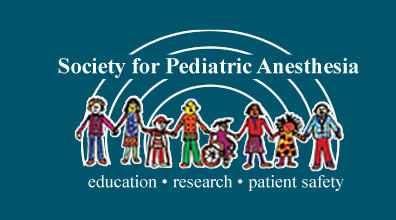The ASA had many wonderful sessions that focused on pediatric care. An example of these is the Panel on Pediatric Trauma submitted by Dr. Govindan.
ASA Pediatric Trauma Session
By Kalyani Govindan, MD
Texas Children's Hospital
In this clinical forum, the speakers discussed the initial assessment and continued management of the pediatric trauma patient including airway management, c- spine protection, volume resuscitation and mechanical ventilation.
The session was moderated by Cathleen Lammers, MD(UC Davis Children’s Hospital).
David Young, MD(Texas Children’s Hospital) opened the forum with discussion about prehospital airway management in a pediatric trauma patient. He discussed the Glasgow Coma Scale, modified pediatric GCS and that a score of less than 8 usually necessitates intubation in the field. According to the PALS guidelines in 2005, bag mask ventilation (BMV) is considered safe and effective in the prehospital setting in a pediatric trauma patient when the transport time is short (< 15 minutes).
The national pediatric trauma registry notes that there are no outcome differences between BMV and ventilation via endotracheal tube and that BMV is usually sufficient to maintain the airway prior to arrival at the hospital. He proceeded to discuss the clinical and radiological evaluations of C- spine injury in the pediatric trauma patient and mentioned that pseudosubluxation at C2- C3 level occurs in up to 40% of the children and has to be differentiated from true subluxation. Also, SCIWORA (spinal cord injury without radiological abnormality) in which the CT and X ray are negative occurs in about 30% of the injuries and the diagnosis needs to be confirmed with MRI.
The safety and utility of the NEXUS (National emergency X radiography utilization study) in children was also discussed. He stressed the importance of C spine immobilization, identifying the difficult airway, other trauma and full stomach during the anesthetic management. Most of the studies show that there was some neck movement during all airway intervention and there is no data to support a specific technique for a pediatric trauma patient.
The final part of Dr. Young’s talk was on the choice of cuffed vs. uncuffed tubes for securing the airway in a pediatric trauma patient and he concluded that cuffed tube was safer in reliably securing the airway, reducing the need for tube exchanges without increasing the risk for stridor.
The next speaker, Dawit Haile, MD (Mayo Clinic) spoke on the pulmonary management of the pediatric trauma patient. He began his discussion with an X ray of a 5 year old intubated trauma patient. The ETT was seen going into the right main stem bronchus, resulting in hyperinflation on the right side and a collapsed left side that was mistaken for hemothorax. The child had a left sided chest tube placed as result of this and when the X ray picture did not improve after the first chest tube, a second one was placed which seemed to go into the abdomen. This resulted in a planned exploratory laparotomy before the endobronchial intubation was recognized and the ETT pulled back into the trachea.
With this, he really stressed the importance of checking the tube position. ASA respiratory closed claims analysis reveals that 20% of inadequate ventilation in pediatric trauma was secondary to tube malposition, whereas in adults this was 9% He also discussed the various methods available for checking the endotracheal tube position and the suprasternal palpation of the cuffed endotracheal tube has an accuracy of 85 – 93%.
The second part of his discussion was about the lung protective ventilatory strategies in trauma child. The goals of ventilation should be to maintain physiologic tidal volumes, limit the inspiratory plateau pressures, permissive hypercapnia and lung recruitment strategies. The controversies surrounding high PEEP and the utilization of increased PEEP to decrease mortality were also discussed.
The final part of his talk was the management of traumatic bronchopleural fistula. Adequate oxygenation and placement of chest tube should be done early on and if the first chest tube did not re-expand the lung to improve oxygenation, a second one should be placed. If there is persistent hypoxemia and leak, further endoscopic evaluation is needed to see if there is a proximal fistula that needs surgical closure.
The nonsurgical treatment in the management of bronchopleural fistulae are 1) conventional ventilation using small tidal volumes, low PEEP and short inspiratory time, 2) negative pressure pleural drainage to balance the air leak, 3) one lung ventilation by isolating the injured lung, 4) high frequency oscillation and jet ventilations, and 5) ECMO. He discussed the various available techniques for isolating the injured lung in children under 2 years of age and 2-6 years of age.
The third speaker, Dolores Njoku, MD (Johns Hopkins University) discussed the fluid resuscitation strategies for the pediatric trauma patient. She stressed the importance of recognizing the types of trauma with significant blood loss, impact of blood volume transfusions and the metabolic changes that occur with banked blood.
According to a study that she quoted, exsanguination is responsible for 39% of pediatric trauma deaths and only 20% of the kids had good IV access on arrival to the ED. The complications of overzealous resuscitation resulting in pulmonary edema, cerebral edema and coagulopathy should not be forgotten. The steps for successful fluid resuscitation are: assess, treat, assess, repeat.
The steps in assessment are evaluating the type of trauma, volume status and intravenous/ intraosseous access. The treatment should be aimed and restoring the volume status with 20 ml/kg of crystalloids initially, then repeating it if there is no improvement in the clinical status and then 10 ml/ kg of PRBC. She discussed the various available options for intraosseous access like Jamshidi, Cook and EZ IO needles. Although there are a lot of studies about the role of hypertonic saline in adult trauma resuscitation, there are no trials in the pediatric trauma patients supporting the role of hypertonic saline.
She concluded her talk with the role of antifibrinolytic agents in pediatric trauma patients. Agents like Desmopressin and Amicar have fallen out of place whereas tranexamic and recombinant Factor VII are used more commonly.
The session ended with the moderator opening the floor for questions and discussion. It was an interesting discussion with practitioners from across the country sharing their experiences in the resuscitation and management of their pediatric trauma patients.


 Click
Click